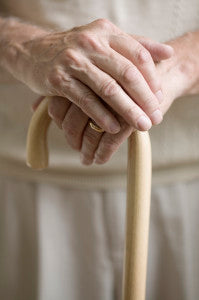
May is National Osteoporosis Awareness and Prevention Month. Do you know someone over the age of 50 who has broken a bone? Perhaps your mother "tripped" in the garden and broke her wrist? Or your neighbor broke his ankle walking on the golf course? Two million broken bones occur every year in the United States due to osteoporosis, but the majority of patients get the fracture fixed without ever realizing they have osteoporosis or low bone mass. The theme for this year's Osteoporosis Month from the National Osteoporosis Foundation is "Break Free from Osteoporosis". The aim of National Osteoporosis Awareness and Prevention Month is to promote good bone health through the prevention, detection and treatment of osteoporosis. The awareness campaign encourages everyone to get to know their risk factors for osteoporosis and change their lifestyle to build and maintain strong bones. An estimated 9 million adults in the U.S. have osteoporosis and over 48 million adults have low bone mass, most will go undiagnosed and untreated.
What is osteoporosis?
Osteoporosis or "porous bone" is a disease of the skeletal system characterized by low bone mass and deterioration of bone tissue. If you look at healthy bone under a microscope, you will see that parts of it look like a honeycomb. If you have osteoporosis, the holes and spaces in the honeycomb are much bigger than they are in healthy bone. This means your bones have lost density or mass and that the structure of your bone tissue has become abnormal. As your bones become less dense, they also become weaker and more likely to break. Osteoporosis leads to an increase risk of bone fractures typically in the wrist, hip, and spine.
How can osteoporosis be prevented?
Osteoporosis and the broken bones it can cause are not part of normal aging. There is a lot you can do to protect your bones throughout your life. You’re never too young or too old to improve the health of your bones. Osteoporosis prevention should begin in childhood. But it shouldn’t stop there. Whatever your age, the habits you adopt now can affect your bone health for the rest of your life. Now is the time to take action. Some steps you can take include:
-
Eating a well balanced diet, including getting enough calcium and vitamin D.
-
Exercise regularly. Doing regular weight-bearing and muscle-strengthening exercise is one of the best ways to protect against osteoporosis and broken bones.
-
Avoid smoking, and limit alcohol intake to no more than 2-3 drinks per day. These things can promote calcium loss.
-
Know your risk factors. Many factors play a role in your risk for osteoporosis, including age, gender, lifestyle, medical history, family history and whether you take any medication or have medical conditions that can lead to bone loss. It is important to talk with your healthcare provider about your risk factors for osteoporosis and together you can develop a plan to protect your bones.
For more information about osteoporosis, risk factors, and prevention, visit the National Osteoporosis Foundation website.
Why is a medical alert system important for seniors with osteoporosis?
Osteoporosis is a chief cause of fractures in older adults, especially among women. What is debatable is whether brittle bones break after a fall, or break when stressed and in turn cause a fall. In either event, a decrease in bone density contributes to falls and resultant injuries. This year 13.5 million people age 65 and older will fall. A medical alert system, like One Call Alert, can help you or your loved ones to continue living independently without fear of being alone if a fracture occurs. A medical alert system can help by connecting you to the right help for the situation, 24 hours a day, 365 days a year at the push of a button, whether you need emergency services or just the assistance of a family member or friend to help you get back on your feet, Sources: National Osteoporosis Foundation, CDC

 1-800-916-0138
1-800-916-0138